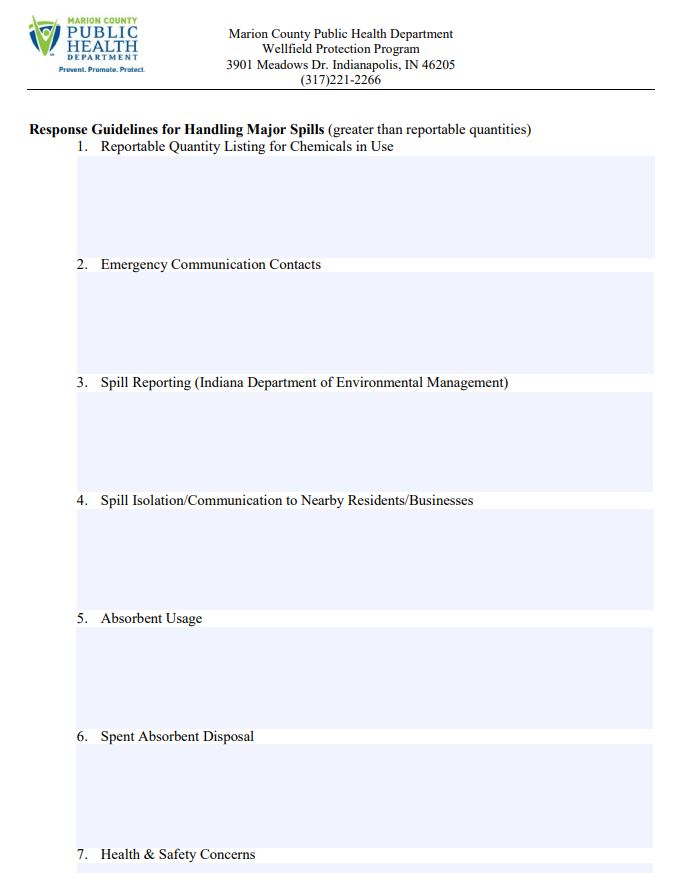Part 1 | Part 2 | Part 3 | Part 4
This is Part 2 in a series about the Emergency Response and Spill Prevention Plan, one of the requirements for many businesses located in Marion County wellfields. The Marion County Public Health Department (MCPHD) provides a spill plan template which is available here. This fillable pdf template is a short four page plan that allows most businesses to produce a straightforward spill plan that is easy to write and use.
Page 2 of the Marion County Public Health Department (MCPHD) Spill Plan template deals with major spills. A major spill is defined as spills where the volume of chemical spilled is larger than the ‘reportable quantity’.
The Questions on Page 2
Question 1 deals with Reportable quantities. What is a reportable quantity? It is the minimum volume of a chemical that must be reported to state authorities if it is spilled. We have an explanatory guide available on our website to help you understand whether you have ‘reportable quantities’ of chemicals on your site. One example is for petroleum products, such as oils or fuels. The reportable quantity for petroleum is 55 gallons or more. So if you had more than 55 gallons of petroleum products stored on your site, you would list those petroleum products under Question 1 of this page. This helps you to know which of your chemicals might require spill reporting in the event of a spill.
Question 2 requires you to list emergency contacts – people you would want to be contacted in the event of an emergency. This can include 911 but can also include a designated person in your company who is tasked with managing emergency situations. Whoever it is that should be contacted in the event of an emergency should be listed here.
Question 3 is for contact numbers of any authorities or utilities that may need to be contacted in the event of a major spill that exceeds reportable quantities. For example, if more than 55 gallons of petroleum spilled at your facility, you would be obligated by law to call the Indiana Department of Environmental Management (IDEM) and your water utility to report the spill. These contact numbers should be listed under this question.
Question 4 covers spill isolation and, if necessary, communication to neighboring properties/residents. In the event of a major spill, you need to have a plan on how to stop the spill from spreading across your property or from leaving your property. A description of what materials you would use to stop a spill (absorbent socks, dikes of oil-dri etc) is needed, along with a note about how you would communicate to a neighbor if a spill entered or threatened their property.
Question 5 requires you to list the various types of absorbents you plan to use to clean up a spill – oil-dri, absorbent pads and so on.
Question 6 asks how you intend to dispose of absorbent materials that are used to clean up a spill. Generally speaking, if the materials are not dripping liquids, then they can be placed in a garbage bag and put in a trash dumpster. If there is a lot of fluid waste, then you may require the services of a waste disposal company. A number of these companies are listed on our website for your convenience.
Question 7 asks what Health and Safety Concerns are involved with cleaning up the spill? Should your employees wear gloves, eye protection or a face mask while performing spill clean up? Are there special concerns with splashing spill materials in eyes or breathing in fumes?
Check out the other posts in this series for more information on filling out the other sections of the Spill Plan.
Part 1 | Part 2 | Part 3 | Part 4

